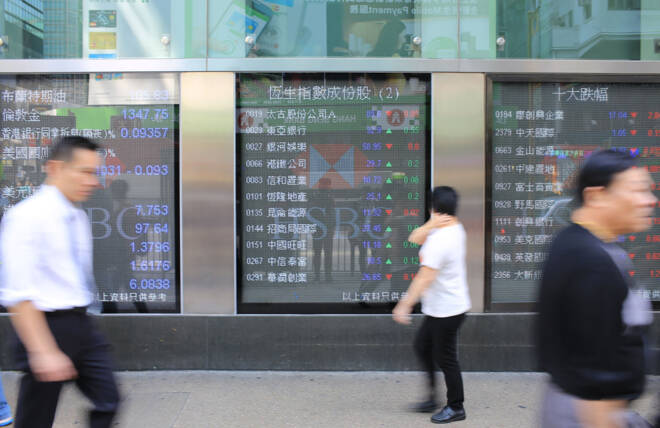Advertisement
Advertisement
Hang Seng Index Slides 1.34% as US Treasury Yields and Tariff Fears Loom
By:
Key Points:
- Hang Seng Index falls 1.34% as Fed hawkishness and US tariff threats weigh on market sentiment.
- China’s exports surge 10.7% YoY in December, reflecting global demand ahead of potential US tariffs.
- ASX 200 tumbles 1.50%, led by banking and tech losses as Wall Street's Friday sell-off ripples through Asia.
US Market Slide on Jobs Report and Fed Sentiment
US markets tumbled on Friday, January 10, as investors reacted to labor market data. The Dow and the Nasdaq Composite Index both posted losses of 1.63%, respectively, while the S&P 500 slid by 1.54%.
In the bond market, 10-year US Treasury yields jumped to a Friday high of 4.788%, suggesting a more hawkish Fed policy outlook.
US Jobs Report Challenges Fed Rate Cut Hopes
The crucial US Jobs Report reflected a resilient US labor market, signaling a more hawkish Fed rate path. Nonfarm payrolls surged by 256k in December, surpassing November’s 212k rise. The jump in nonfarm payrolls led to an unexpected fall in the unemployment rate from 4.2% in November to 4.1% in December.
This stronger labor market could drive wage growth, fueling consumer spending and demand-driven inflation. Rising inflation may delay the timelines for Fed rate cuts. Higher borrowing costs could weigh on corporate earnings and valuations, further impacting stock market sentiment.
While US market losses influenced a sell-off in Asia, Chinese trade data offered some optimism amid US tariff concerns.
China Sees Surge in Demand Amid US Tariffs Concerns
On Monday, January 13, China’s trade data drew investor interest as US tariffs loomed. Exports surged by 10.7% year-on-year in December, up from 6.7% in November. The upward trend in exports indicated a marked improvement in global demand for Chinese goods. CN Wire reported that exports to the US increased by 4.9% year-on-year.
Imports rose 1.0% year-on-year after falling 3.7% in November. The recovery in imports signaled a pickup in domestic demand.
Brian Tycangco, editor and analyst at Stansberry Research, commented on the trade data, stating,
“The Trump tariff effect. What normally is a quiet month for business for Chinese exporters turned out to be a boon likely driven by orders ahead of potential new tariffs once President-elect Trump gets back to the Oval Office later this month.”
Hang Seng Index Slides on Fed and Tariff Fears
In Asian markets, the Hang Seng Index fell 1.34% on Monday morning. Fears of a hawkish Fed and rising threats of US tariffs weighed on risk sentiment.
Tech stocks led the losses. The Hang Seng Tech Index declined by 1.28%, with tech giants Baidu (9888) and Alibaba (9988) tumbling by 2.96% and 2.20%, respectively. The Hang Seng Mainland Property Index bucked the trend, edging 0.12% higher on hopes of China stimulus.
Mainland China’s equity markets also faced selling pressure after last week’s heavy losses. The CSI 300 and Shanghai Composite declined by 0.47% and 0.45%, respectively.
Nikkei Futures Sink
On Monday morning, Japan’s Nikkei Futures fell 480 points. Investors reacted to the US Jobs Report and the jump in Treasury yields. However, a stronger Japanese Yen added to the selling pressure, with the USD/JPY dropping by 0.13% to 157.490. Japan’s markets were closed on Monday for Respect for the Aged Day.
ASX 200 Tumbles, Mirroring Wall Street’s Sell-Off
Australia’s ASX 200 Index tracked Friday’s US market losses, tumbling by 1.50% on Monday morning. Banking and tech sector stocks contributed to the losses.
The S&P/ASX All Tech Index slumped by 2.96% on the prospect of higher borrowing costs. Friday’s surge in US Treasury yields fueled the banking sector sell-off. The Commonwealth Bank of Australia (CBA) slid by 2.83%, with Westpac Banking Corp. (WBC) down 2.76%. Rising US Treasury yields make Aussie bank stocks less attractive to global investors seeking yield, leading to selling pressure.
Amid the sell-off, Woodside Energy Group (WDS) rallied 2.26% after the US threatened tougher sanctions against companies associated with Russia’s oil production and distribution. WTI Crude Oil was up 1.68% to $77.86 on Monday, extending its gains from Friday.
Outlook
Global economic uncertainties remain key drivers of market sentiment:
- Persistent US-China tensions threaten regional economies.
- A resilient labor market, reflected in the latest jobs report, challenges expectations of near-term Fed rate cuts, pressuring rate-sensitive sectors such as banking and technology.
- Chinese stimulus efforts may provide a counterbalance to the effects of US tariffs on global trade.
Investors face a challenging period as trade tensions and monetary policy shifts influence asset prices. Explore how these developments could impact your portfolio here.
About the Author
Bob Masonauthor
With over 28 years of experience in the financial industry, Bob has worked with various global rating agencies and multinational banks. Currently he is covering currencies, commodities, alternative asset classes and global equities, focusing mostly on European and Asian markets.
Did you find this article useful?
Latest news and analysis
Advertisement
